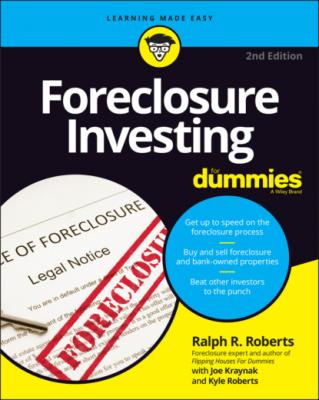Foreclosure Investing For Dummies. Ralph R. Roberts
Чтение книги онлайн.
Читать онлайн книгу Foreclosure Investing For Dummies - Ralph R. Roberts страница 15
 Possession of the Property
Possession of the Property
When you buy a house, you usually expect to move into it on the agreed-upon date. You and the seller sign a purchase agreement in which the seller agrees to vacate the premises and turn over the keys on a specified date. Sometimes, the buyer requests possession at closing. In other cases, the seller agrees to move out one or two weeks later.
With foreclosures, the transfer of a property can be a long, drawn-out, and messy affair. In some areas, you take immediate possession of a property as soon as you offer the winning bid and pay the trustee or courtroom clerk. In other cases, the homeowners retain possession of the property for the duration of the redemption period, which can last up to a year in some areas.
Even when the redemption period is over, you have no guarantee that the previous homeowners are going to vacate the premises in a quiet, orderly fashion when their time runs out. In some cases, you can gently encourage the homeowners to move out. In other cases, you must have them forcibly evicted (by the sheriff, not you), which is always a painful process for all parties.
In the following sections, I provide an overview of what to do to take formal ownership of a property and eventually take possession of it. In Chapter 16, I reveal your responsibilities as the new owner and cover the eviction process in more detail.
Completing the essential paperwork
When you purchase a property directly from the homeowners, you and the sellers attend a closing in which a title company’s agent or an attorney shuffle all the paperwork and file the necessary records.
When you purchase a property at an auction or sheriff’s sale, however, you receive the deed, which you must then record at the Register of Deeds office to have your name officially added to the title. See Chapter 11 for details.
Paying property taxes and insurance
As soon as you purchase a property, either from the homeowners or at an auction, you become the official owner of the property, even though you may not be able to take immediate possession of it. As owner, you’re in charge of insuring the property and paying property taxes. Be sure to do the following:
Call your insurance agent to obtain a homeowner’s insurance policy for the property.
Pay the property taxes as soon as they’re due. (You may need to pay back taxes when you purchase the property.)DON’T FORGET THE INSURANCEAs soon as you buy a foreclosure, even if you can’t take possession of it right away, call your insurance agent and buy a homeowner’s insurance policy for the property.I once purchased for $75,000 a house that was worth $150,000. By the time I took possession of the property, the previous owners had taken the carpeting, the entire kitchen (including the sink), the bathroom fixtures, the furnace, the central air conditioning unit, the doors, and everything else they could carry out, hoping to stick it to the next owners. I turned the claim in to my insurance carrier, received $25,000, and sold the house to another investor for $100,000. After expenses and holding costs, I walked away with about $35,000.The investor who bought the property decided to rent it instead of selling right away. He refinanced to pull about $50,000 equity out of the property, used the equity to cover repair and renovation costs, and still had a little money left over. Then he rented the property to cover his mortgage payments.
File an affidavit proving that you paid the insurance and property taxes. If the homeowners decide to redeem the property, an affidavit enables you to recover any taxes and insurance payments you made during the redemption period.
See Chapter 16 for details concerning your responsibilities as a homeowner during the redemption period.
Persuading the current residents to move on
As the official owner and soon-to-be possessor of the property, your goal is to encourage the homeowners to move out without trashing the place or forcing you to evict them. You want the property to be broom-clean and in the same condition it was in when you first inspected it — or better. The key to success in this area is providing the homeowners an easy exit. Following are some suggested perks for assisting the homeowners out the door:
Offer cash for keys and a nonredemption certificate — a signed agreement that the homeowners promise not to redeem the property.
Provide a dumpster in which the homeowners can toss anything they don’t want to move.
Offer to pay for a moving van, or pay a portion of their relocation costs.
Offer to pay the first month’s rent on a rental unit.
Cashing Out: Realizing Your Profit
Assuming that you purchase a property for the right price, you’ve already profited from it, but you won’t see that profit until you cash out your chips. Various cash-out strategies are available, as I discuss in Part 5. The following sections provide a brief overview of your cash-out options.
Repairing and renovating the property to maximize its value
The most common way to maximize your profit is to repair and renovate the property and then place it back on the market in the shortest possible time. Time is of the essence, because every day you hold a property costs you — in monthly payments (if you financed the purchase), property taxes, insurance, and utilities.